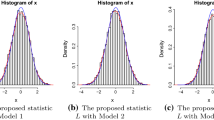Abstract
The Tryon-Kaiser solution for the communalities is reviewed. Numerical investigation suggests that the procedure is applicable if and only if the correlation matrix has unique minimum rank communalities. This implies that this approach to the communality problem is not general enough to be of practical use.
Similar content being viewed by others
References
Albert, A. A. The minimum rank of a correlation matrix.Proc. nat. Acad. Sci., 1944,30, 144–148.
Guttman, L. “Best possible” systematic estimates of communalities.Psychometrika, 1956,21, 273–285.
Kaiser, H. F. Solution for the communalities: a preliminary report. Rep. No. 5, Contract No. AF 41(657)-76, Univ. California, 1956.
Ledermann, W. On the rank of the reduced correlational matrix in multiple factor analysis.Psychometrika, 1937,2, 85–93.
Scarborough, J. B.Numerical mathematical analysis. (2nd ed.) Baltimore: Johns Hopkins, 1950.
Tryon, R. C. Communality of a variable: formulation by cluster analysis.Psychometrika, 1957,22, 241–260.
Author information
Authors and Affiliations
Rights and permissions
About this article
Cite this article
Kaiser, H.F. A note on the Tryon-Kaiser solution for the communalities. Psychometrika 24, 269–271 (1959). https://doi.org/10.1007/BF02289850
Received:
Revised:
Issue Date:
DOI: https://doi.org/10.1007/BF02289850



